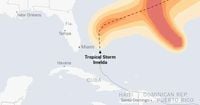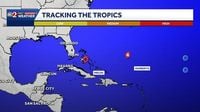Tropical Storm Imelda, the ninth named storm of the 2025 Atlantic hurricane season, formed on Sunday, September 28, 2025, setting off a flurry of warnings and preparations across the Bahamas and the U.S. Southeast. As meteorologists tracked the system’s progress and Hurricane Humberto’s powerful churn through the Atlantic, residents and officials braced for a week of rough seas, heavy rainfall, and the ever-present risk of sudden escalation that has come to define hurricane seasons in recent years.
According to the National Hurricane Center (NHC), Imelda was situated about 320 miles southeast of Cape Canaveral, Florida, and 125 miles northwest of the central Bahamas late Sunday night, moving north at 9 mph. By 5 p.m. that day, the storm had edged closer—just 55 miles south-southwest of the Northwest Bahamas and 355 miles southeast of Cape Canaveral—still on a northwesterly track and packing maximum sustained winds of 40 mph. The NHC’s forecasts warned that Imelda was expected to strengthen over the Bahamas on Monday, September 29, and likely become a major hurricane by Monday night or early Tuesday, September 30.
While the U.S. East Coast was forecast to be spared the brunt of Imelda’s force, forecasters cautioned that the Carolinas could see significant rainfall. "Storm total rainfall amounts of 2 to 4 inches with local maxima of 6 inches are expected through Tuesday across coastal South Carolina into southeast North Carolina," the NHC stated in its Sunday evening forecast. This, they warned, could trigger isolated flash, urban, and minor river flooding, with minor coastal flooding possible in areas subject to onshore winds along the Southeastern U.S. coastline.
National Hurricane Center deputy director Jamie Rhome addressed the public in a Sunday evening video post, noting, "While the impacts for the U.S. are coming down, they're not zero, there will still be some impact for the East Coast of the United States." He went on to highlight a high rip current risk stretching from southeastern Florida up the east coast, through coastal Georgia, much of coastal South Carolina, and the Outer Banks of North Carolina. "For the next couple of days, the rip current risk is going to be high, so make sure you're being safe going to the beach over the next couple of days, always swim near a lifeguard and check local beach conditions," Rhome urged.
Imelda’s approach prompted tropical storm warnings across the Bahamas, including Cat Island, the Exumas, Long Island, Rum Cay, San Salvador, Eleuthera, New Providence, the Abacos, Berry Islands, Andros Island, and Grand Bahama Island. A tropical storm warning, according to Gulf Coast News, means tropical storm-force weather conditions are expected within 36 hours, while a tropical storm watch signals the possibility of such conditions within 48 hours. Tropical storm warnings also extended to waters off the U.S. East Coast, though the core of the storm was forecast to remain offshore as it intensified.
As Imelda moved north, South Florida found itself on the edge of the storm’s influence. Wind gusts over 30 mph were possible in northern Broward County on Monday, September 29, with winds turning northwest and blowing offshore. Although coastal flooding was not expected in South Florida, the area faced a high risk of rip currents due to increased swells from the storm. "Rough seas and surf will likely continue as the storm slowly turns east and moves away from the coast later this week," meteorologists reported. Rainbands were expected to sweep across the region, but severe weather was unlikely. Drier and more stable air was forecast to arrive in South Florida early in the week, bringing a welcome reprieve for residents weary of tropical threats.
Meanwhile, Hurricane Humberto, which had rapidly intensified into a Category 5 storm on Saturday, September 27, weakened slightly to a Category 4 by Sunday evening. As of 11 a.m. on September 28, Humberto was about 450 miles north of the Northern Leeward Islands and roughly 535 miles south of Bermuda, moving west-northwest at 13 mph with maximum sustained winds of 150 mph. By 11 p.m., Humberto maintained Category 4 strength, with sustained winds at 140 mph, and continued on a northwest track at 14 mph. Swells from Humberto were expected to reach the northern Leeward Islands, Puerto Rico, and Bermuda on Sunday night, and the U.S. East Coast through Monday, September 29. The storm was forecast to turn north and then northeast, passing north of Bermuda early in the week before accelerating into the North Atlantic, sparing the U.S. and Canada from direct impact but keeping Bermuda on alert.
Both Imelda and Humberto are emblematic of a hurricane season that, while quieter than some recent years, has seen storms intensify rapidly and unpredictably. The National Oceanic and Atmospheric Administration (NOAA) projected 13 to 18 named storms for the 2025 season, with five to nine expected to become hurricanes. Imelda was the ninth named system, and Humberto, the eighth, had already achieved Category 5 status before its recent weakening. These rapid intensifications, as highlighted by Axios, are increasingly linked to climate change, which has been shown to boost the intensity and maximum wind speeds of Atlantic hurricanes. Research cited by multiple outlets confirms that hurricanes are not only forming more quickly but are also growing stronger, posing greater risks to coastal communities.
The storm’s approach has tested emergency preparedness across the region. In the Bahamas, tropical storm warnings and watches kept residents on edge, with authorities urging vigilance as Imelda’s outer bands threatened to bring heavy rain and gusty winds. Along the U.S. coast, officials reminded beachgoers and boaters of the dangers of rip currents and rough surf, stressing the importance of checking local advisories and heeding lifeguard instructions. In the Carolinas, the focus turned to flood preparedness, as several inches of rain could overwhelm urban drainage systems and low-lying rivers.
For many, the Atlantic hurricane season is a familiar cycle of watching, waiting, and hoping for the best. Yet, as storms like Imelda and Humberto demonstrate, the unpredictability of these systems—fueled in part by a warming climate—means that vigilance and adaptability remain crucial. With the season running through November 30, residents and officials alike will be keeping a close eye on the Atlantic, ready to respond as the next storm takes shape.
As the week unfolds, forecasters will continue to monitor Imelda’s progress and Humberto’s path, providing updates and guidance to help communities stay safe. For now, the message is clear: while the worst may be avoided, the risks are real, and preparation is key.






